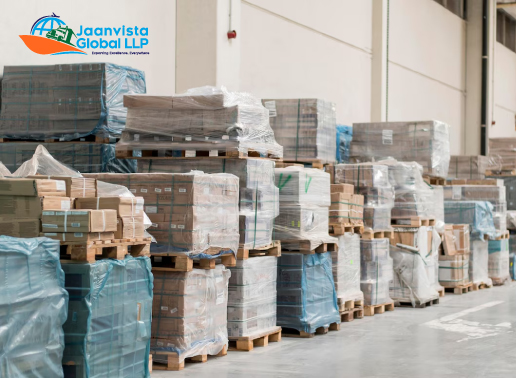
In the competitive world of international shipping, ensuring that products reach their destinations safely and in optimal condition is crucial. Jaanvista understands that export packaging plays a vital role in protecting goods during transit, minimizing damage, and reducing losses. Whether you are engaged in the export-import business or seeking cheap international shipping solutions, using the right worldwide shipping practices will ensure efficiency and cost-effectiveness.
Beyond just safeguarding goods, export packaging also influences transportation costs, customs clearance, and customer satisfaction. Poor packaging can lead to product returns, increased operational expenses, and reputational damage. Businesses must balance durability, cost-effectiveness, and compliance with international trade standards to ensure smooth global transactions. In a global market where efficiency is key, optimizing export packaging can significantly enhance supply chain operations.
What is Export Packaging?
Export packaging, also known as international shipping packaging, involves designing and selecting the right materials and methods to protect products during global transit. It must comply with international regulations, withstand harsh environments, and align with the logistical demands of different markets. Proper packaging reduces the risks associated with international shipping rates, ensuring cost-effective and damage-free delivery.
Types of Export Packaging
1. Primary Packaging: This is the immediate layer that holds the product, such as bottles, boxes, and wrappers. It provides essential protection and branding for consumer goods, ensuring product integrity.
2. Secondary Packaging: Used to group multiple primary packages, providing additional protection. Examples include cartons, crates, and shrink wrap, which help with stacking and organization, reducing transportation costs.
3. Tertiary Packaging: Designed for bulk handling, storage, and shipping. This includes pallets, shipping containers, and stretch wraps. It plays a crucial role in optimizing space, preventing damage during transit, and facilitating efficient loading and unloading processes.
Key Considerations in Export Packaging
1. Material Selection
Choosing the right packaging materials depends on the type of product, destination, and shipping method. Common materials include:
• Corrugated Boxes: Ideal for international shipping companies as they provide cushioning and strength while remaining lightweight, ensuring cost-efficient transportation.
• Wooden Crates: Used for heavy and fragile goods that require enhanced protection, making them suitable for delicate machinery, glassware, and other breakable items.
• Plastic Containers: Resistant to moisture and suitable for perishable and high-value items such as food, medical supplies, and electronic components.
• Foam and Bubble Wraps: Essential for protecting delicate products from vibrations and impact during transportation, preventing cracks, dents, and damage.
2. Compliance with Global Regulations
Each country has different packaging standards and import regulations. Key regulatory bodies include:
• ISPM 15 Standard (for wood packaging materials in international trade) ensures pest-free shipments, reducing the risk of contamination and rejection at customs.
• EU Packaging Regulations (for sustainability compliance) encourage the use of recyclable and biodegradable materials, promoting eco-friendly shipping practices.
• U.S. FDA Regulations (for food and pharmaceutical exports) mandate safe, non-toxic materials for packaging consumable goods, ensuring product safety and regulatory adherence.
3. Cost-Effective and Eco-Friendly Solutions
With rising international shipping rates, businesses are focusing on lightweight and recyclable packaging materials to reduce costs. Sustainable packaging not only saves money but also enhances brand reputation in global markets. Companies that adopt eco-friendly export packaging solutions are more likely to gain consumer trust and comply with evolving environmental policies. Using biodegradable alternatives such as cornstarch-based plastics, recycled paper, and plant-based foams helps in reducing the carbon footprint of the export-import business.
The Role of Export Packaging in the Global Supply Chain
1. Ensuring Product Safety
Proper export packaging prevents damage from:
• Rough handling at various transit points, such as loading docks, warehouses, and distribution centres.
• Extreme weather conditions, including humidity, temperature fluctuations, and exposure to rain, which can damage sensitive items.
• Long-distance transportation risks such as compression, shocks, and vibrations during transit in cargo ships, airplanes, and trucks.

2. Enhancing Supply Chain Efficiency
A well-structured global supply chain depends on optimized packaging for:
• Easy stacking and storage: Reducing warehouse space requirements and improving inventory management through efficient design.
• Quick identification and tracking: Standardized barcodes, RFID tags, and QR codes enable efficient scanning, tracking, and inventory control.
• Faster customs clearance: Proper labelling and documentation prevent delays at international borders, ensuring smooth transit through regulatory checkpoints.
3. Reducing Shipping Costs
With rising international shipping rates, businesses are focusing on lightweight and recyclable packaging materials to reduce costs. Jaanvista recognizes that sustainable packaging not only saves money but also enhances brand reputation in global markets. Companies that adopt eco-friendly export packaging solutions are more likely to gain consumer trust and comply with evolving environmental policies. Using biodegradable alternatives such as cornstarch-based plastics, recycled paper, and plant-based foams helps in reducing the carbon footprint of the export-import business.
Best Practices for Export Packaging :
1. Use Standardized Packaging
Global businesses prefer standardized packaging solutions to streamline logistics and maintain uniformity in exports. Standardized cartons, pallets, and shipping containers improve efficiency and reduce the risk of damage during handling. Implementing a universal packaging standard simplifies cross-border trade and enhances predictability in freight costs.
2. Implement Protective Measures
Using impact-resistant materials, moisture-proof packaging, and temperature control can prevent product deterioration during transit. Cushioning techniques, vacuum-sealing, and insulated liners help ensure product integrity in extreme conditions. Desiccants and vapor barriers also protect against moisture, preventing mould growth and corrosion.
3. Proper Labelling and Documentation
Correct labelling ensures compliance with international trade regulations. Essential elements include:
• Product name and description: Clear identification of goods to prevent confusion.
• Handling instructions: Symbols and labels indicating fragility, temperature requirements, and stacking limitations.
• Country of origin: Essential for customs clearance, taxation, and duty calculations.
• Import/export declarations: Accurate paperwork to prevent delays, fines, and shipment rejections.
Future Trends in Export Packaging
1. Smart Packaging Solutions
The adoption of smart packaging is revolutionizing global trade. Technologies such as RFID (Radio Frequency Identification) and IoT (Internet of Things) sensors allow real-time tracking of shipments, reducing the risks of loss or damage. Smart sensors can monitor temperature, humidity, and handling conditions, alerting businesses to potential issues before they escalate.
2. Sustainable Packaging Innovations
As environmental concerns grow, companies are investing in biodegradable, compostable, and reusable packaging materials. Innovations such as edible packaging for food products and plant-based plastics are reshaping the industry, offering alternatives to traditional non-recyclable materials.
3. Automation in Packaging Processes
Automation in export packaging is enhancing speed and accuracy. Robotic systems and AI-driven packaging solutions help businesses reduce human errors, increase production capacity, and ensure consistent packaging quality. Automated systems improve efficiency, lower labour costs, and ensure adherence to industry standards.
Conclusion
Export packaging is a critical element of successful worldwide shipping. Choosing the right materials, ensuring compliance with international standards, and adopting cost-effective solutions will help businesses minimize risks and enhance efficiency. Whether you are dealing with international shipping companies or optimizing your global supply chain, prioritizing high-quality packaging will contribute to seamless trade and customer satisfaction.
As businesses continue to expand globally, Jaanvista emphasizes the importance of investing in innovative and sustainable export packaging strategies to stay competitive in the dynamic world of international trade. A well-planned packaging approach can drive operational success, improve brand credibility, and enhance overall business performance in the international market.
